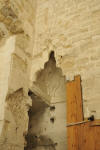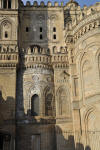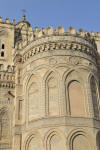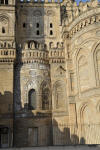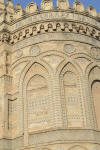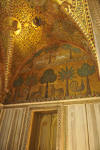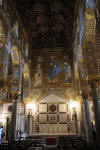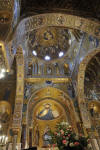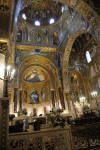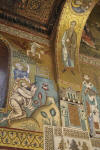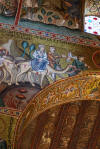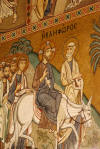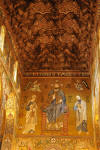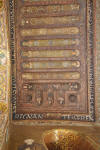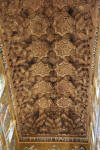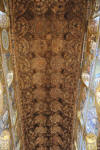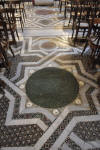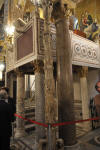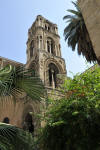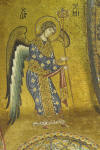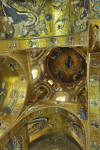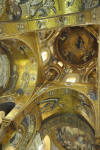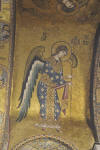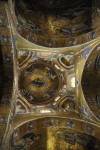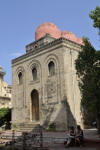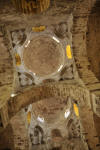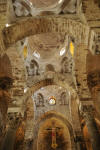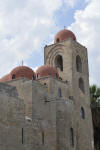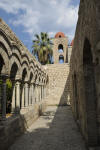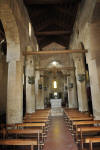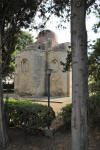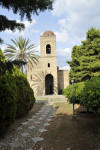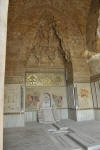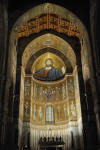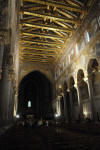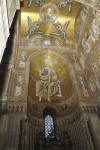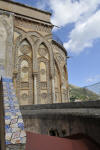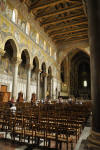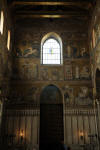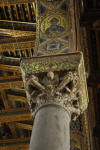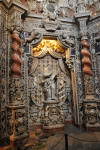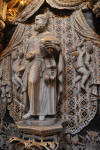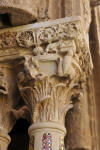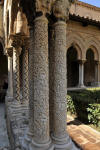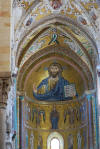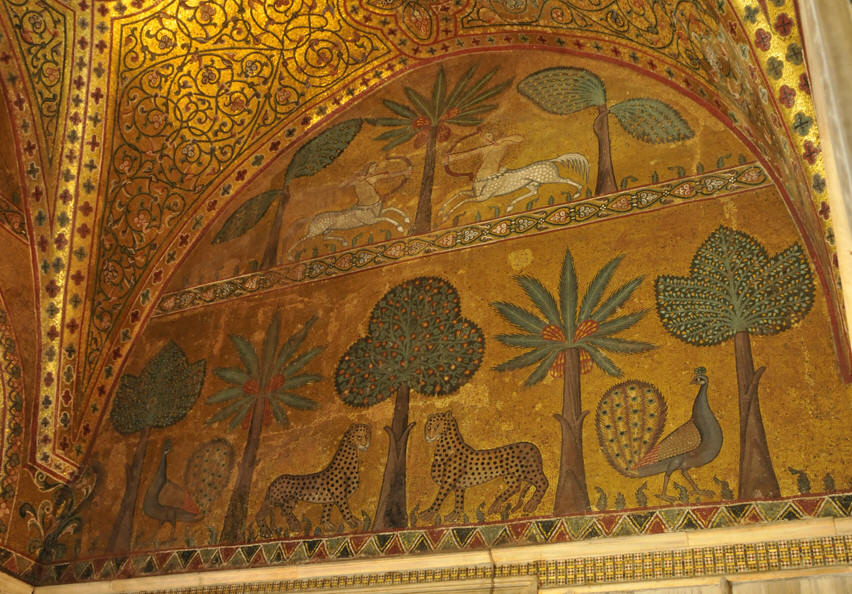
Norman Sicily
of the 12th Century
The spectacular confluence of Islamic, Byzantine, and Norman art and architecture in the Latin Kingdom of Sicily.
The Arab-Norman Kingdom of Sicily became the most culturally advanced court in the richest country of the Mediterranean world during the years between 1071 and 1194. Previously, the early establishment of Byzantine cultural dominance was ended with invasion by Arabs from North Africa, then known as Ifriqia, in 876. There followed a struggle between the proto Sunni and Shia factions ending with Fatimid dominance on the island. The two centuries of Muslim rule were a period of economic and demographic florescence as the Arabs introduced more sophisticated governmental administration and agricultural technology, doubling the population of the island. The rule of the Arab emirs ended with the invasion by the Normans who enjoyed papal support and the hope that they would begin to Latinize the island. However, political reality dictated a policy of tolerance as the Normans, thin on the ground, relied on Muslim administrators who had been successfully governing the island for 200 years. The fact is that the Normans, the Hautevilles - not long descended from Vikings – came to appreciate and admire the rich and layered culture in which they now found themselves, taking on the attributes of Muslim rulers in dress, language, literature, and even in the presence of palace eunuchs and according to some accounts, a harem. Like the multi-ethnic Caliphate of Cordoba, then only just eclipsed, the court of Roger II became the most luminous center of culture in the Mediterranean, attracting scholars, scientists, poets, artists and artisans of all kinds. In Arab-Norman Sicily laws were issued in the language of the community to whom they were addressed: the governance was by the rule of law so there was justice. Muslims, Jews, Byzantine Greeks and Latin Normans worked together to form a society that created some of the most extraordinary buildings the world has ever seen. Indeed, for one brief shining moment Arab-Norman Sicily was the most civilized place in the western world, even beyond the Latin Kingdom of Jerusalem, a place coarse and crude by comparison, where other Normans had set themselves up as kings. The difference was that in Sicily the new fusion culture was inclusive by design, where in Jerusalem it was exclusive by design. They both failed, in the end, but for different reasons. Roger dreamed of a larger empire where tolerance encouraged advancement. He ran out of time, and his successors, perhaps seduced by the luxury of their own successes, lacked the vigor to realize the dream. When the Normans were superseded by the Hohenstaufens there began a deliberate policy of genocide against the Muslims and the Jews and the moment of high culture passed, but not into oblivion. As in Spain, there was a long and lingering twilight of Islamic culture in Sicily. Even today the language used there testifies to this, as do the standing buildings from one of the great moments of world history.
Gallery
|
The Cathedral of Palermo
Royal Palace, Room of Roger II
(Cassaro,from Arabic qsar, of Roger II, ca 1140, especially interior. Built by the Arabs over the ruins of a Roman fort, it became the palace of Roger II who enlarged it, employing Muslim architects and craftsmen, it was used by his successors until the time of Frederick II . In particular the Hall of Roger II shows original mosaics of hunting scenes with a strong Persian influence, with plants and animals in a naturalistic and slightly naive style, presenting centaurs, lions, leopards, deer, peackocks and owls amid palm and fruit trees.
Palatine Chapel
1140, first floor of Palazzo dei Normanni, especially the mosaics and muquarnas ceiling and Kufic script extolling Roger II
Santa Maria dell ‘Ammiragliatto (St. Mary’s of the Admiral, also called the Martorana) 1143, founded as a Greek Orthodox church by George of Antioch, Chief officer of Roger, whose title was Amir, rendered in English as Admiral.. Especially inscription around base of the dome on a wooden frieze, a hymn to the Virgin in Arabic. In Antioch in his youth George would have heard this and other hymns sung in Arabic, as indeed one may do today. The church was converted to the Latin Roman Rite in the 13th century. Although much of the original fabric has been changed in later centuries, some sections retain their original Arab-Norman aspect, and include what some believe to be the finest mosaics ever executed in Sicily by the finest Byzantine masters of the era brought from Constantinople for this work and that in the Norman palace and the Cathedral of Celafu. The bell tower is said to be one of the finest works or Arab-Norman building on the island.
San Cataldo
1154-1161 Nuilt by Maio of Bari, Emir of King William I, the Bad. It is the seat of the knights of the Holy Sepulchre. With its three hemispherical domes and Norman style stone work, it is another example of the Arab-Norman fusion on 12th century Sicily.
San Giovanni dei Eremiti
(St. John of the Hermits), Ordered by Roger II in 1130 for the Benedictine order, this is another example of Arab-Norman architecture, actually built over a mosque.
San Giovanni dei Lebbrosi
(St. John of the Lepers)1155 This was an Arab building in use before the arrival of the Normans in 1071, probably a qsar, or fort, but possibly a mosque. After the conquest it was consecrated as a church, making it the first Christian Church in Norman Palermo. Later, in the 12th century it became the conventual church of the order of St. Lazarus which built a leper hospital here. There was a hospital near this site until the mid 20th century.
La Zisi Palace,
1166, completed by William II, 1166-1189, Collection of Islamic art on second floor, the title comes from the Arabic word Aziz for magnificent or luminous or gleaming. This palace, like many others built in Sicily by the Arabs for themselves and later for the Normans, was once surrounded by lush agricultural plantations of fruit trees and irrigated field crops and has direct connections with similar palaces set in agricultural estates in North Africa, Egypt and Syria, including the early Unayyad Desert Palaces
La Cuba 1180(inspired by mausoleums of Ifriquia and Egypt)
Admiral’s Bridge, 1130-1140 Built during the reign of Roger II under the direction of George of Antioch, King Roger’s admiral, or amir. 75 meters long, 18 meters wide, it survives intact as built, a tribute to the excellence of the Arab masons of Sicily.
Santo Spirito, 1178
Monreale Cathedral
Founded by William II, the Good, in 1172. William spoke, read and wrote Arabic and had many Muslim advisors and administrators in his court. Like other Arab-Norman buildings, this building was built by Muslim and Byzantine artisans working together. In this most spectacular example of the cultural fusion taking place in 12th century Sicily, these artisans created one of the largest displays of mosaic art in the world covering over six thousand square meters. Only the Church of Saint Sophia in Constantinople, today known as Aya Sophia in Istanbul, had a larger display, now mostly lost. This lavish use of mosaic decoration in a locus of sacred ritual performance has parallels with the displays that may be seen at the Great Umayyad Mosque of Damascus and the Dome of the Rock in Jerusalem, although these do not include representations of human or animal life. In the adjoining cloister there is evidence of artistic style coming from Provence in the 228 historiated capitals surrounding the patio. It is believed that three of the five artisans responsible for the work were Provencal. There is also a much later Ultra Baroque chapel with some astonishingly fine marble work.
Cefalu and the Cathedral of Cefalu
Cathedral founded in 1131 in the reign of Roger II, it was completed many years later. More typical of North European Romanesque, it contains some of the finest mosaics on the island.


